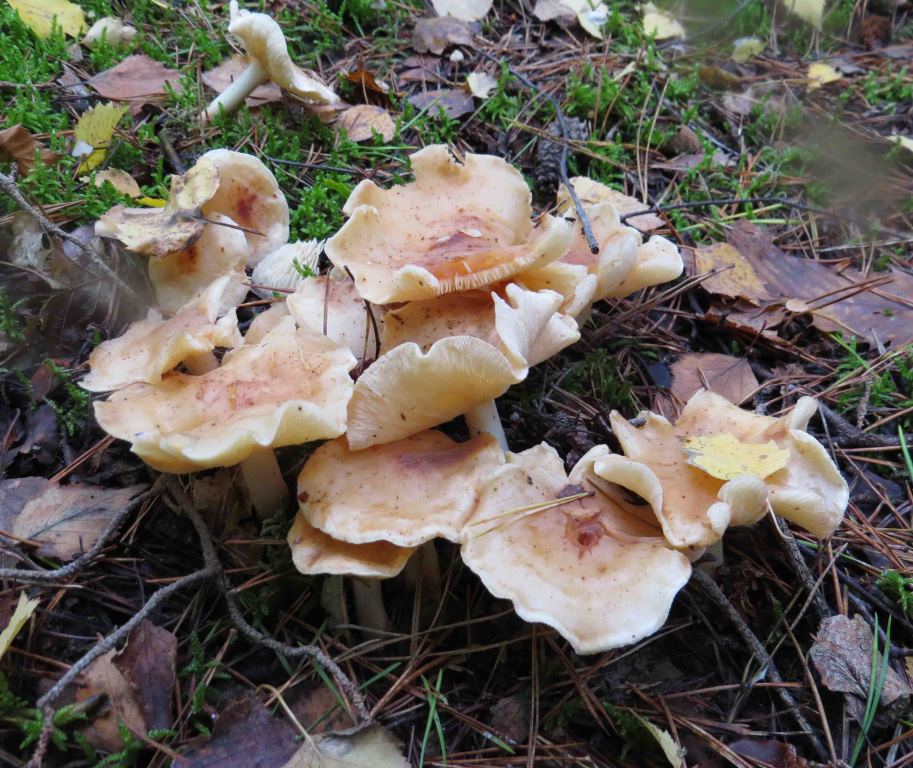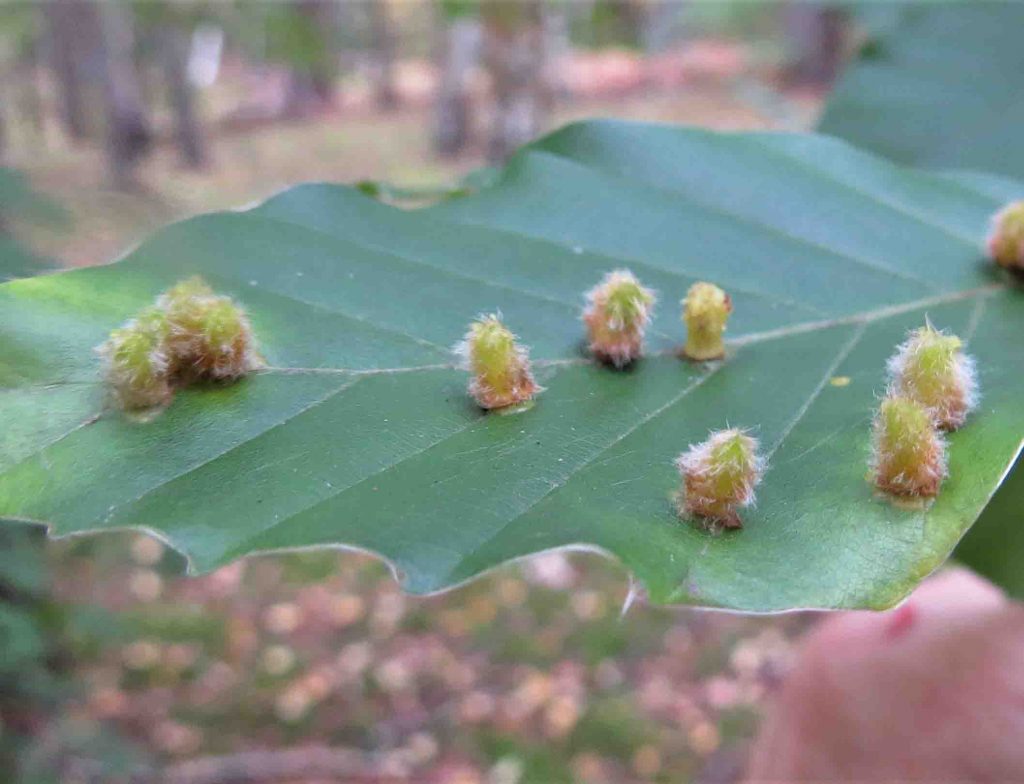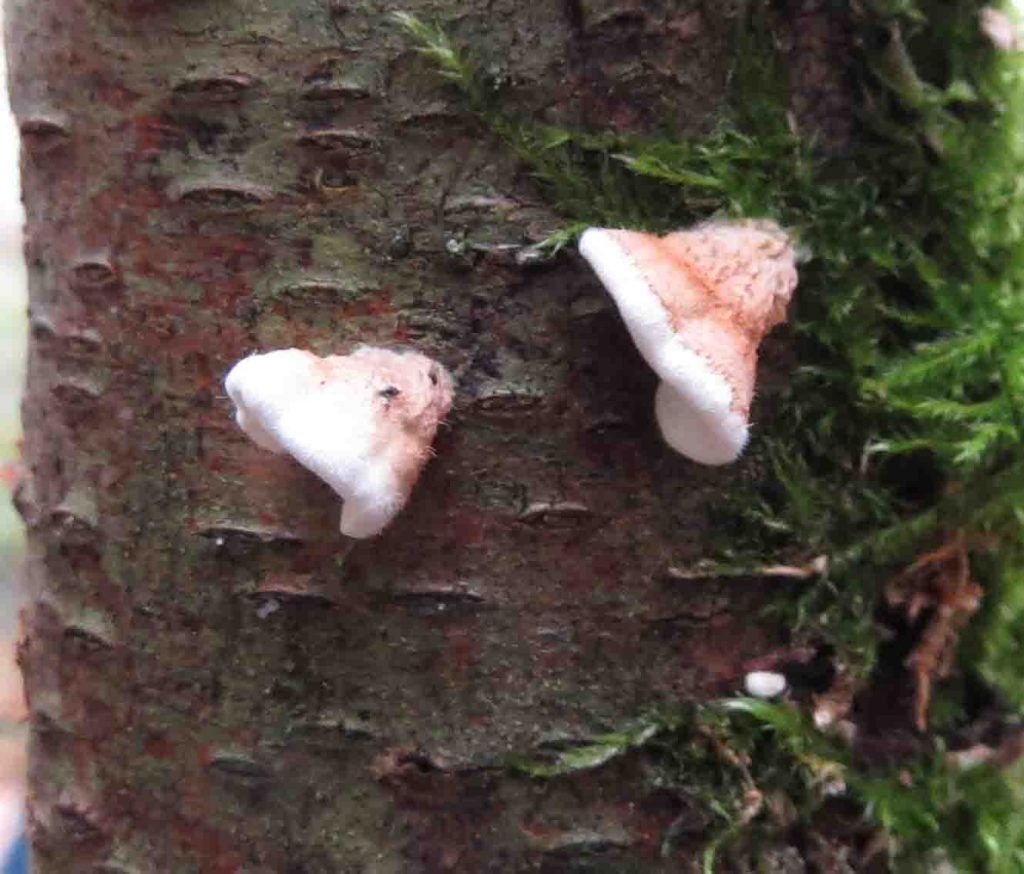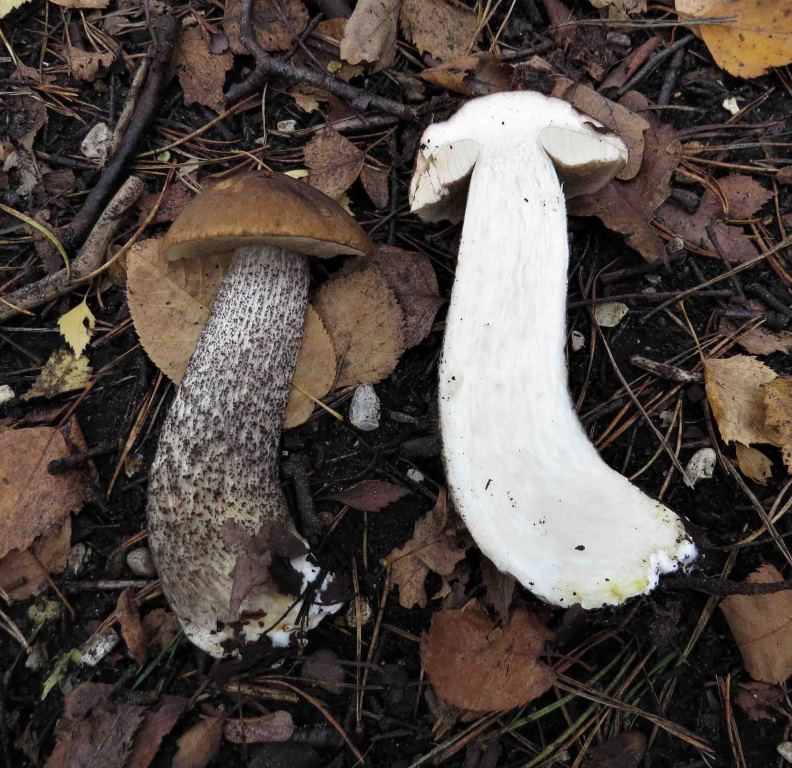Mike Waterman kindly led two fungus identification walks, the first in the morning and the second in the afternoon, on Saturday 17 October at Heath Lake local nature reserve at Crowthorne. The site is a SSSI and is managed by Wokingham District Council. The walks started in the north-east corner of the reserve in an area of woodland dominated by Scots Pine and Sweet Chestnut. Progress was slow, since there were a wide variety of fungi on the woodland floor, including Poisonpie Hebeloma crustuliniforme, Snapping Bonnet Mycena vitilis and Candlesnuff Xylaria hypoxylon on a dead branch. Mike demonstrated that the Milking Bonnet Mycena galopus exudes milk-like droplets when the stem is snapped. Common Rustgill Gymnopilus penetrans was found on rotting conifer wood. Good numbers of the tiny Conifer Conecap Baeospora myosura were growing on pine cones. Several specimens of rotten broad-leaved wood were found to have been stained turquoise by the Green Elfcup Chlorociboria aeruginascens. One of the fungi which was seen repeatedly throughout the walk was the Brown Rollrim Paxillus involutus. Its gills stain darker brown if bruised and it is associated with birch. Other Birch-linked fungi included the Birch Polypore Piptoporus betulinus and the bright red Fly Agaric Amanita muscaria. Also seen here were Amethyst Deceiver Laccaria amethystina, Ugly Milkcap Lactarius turpis, Ochre Brittlegill Russula ochroleuca and Spotted Toughshank Rhodocollybia maculata. Several bracket fungi were found, including the Blushing Bracket Daedaleopsis confragosa, which stains pink when bruised and the Purplepore Bracket Trichaptum abietinum which grows on the dead wood of coniferous trees. The distinctive galls of the midge Hartigiola annulipes were found on the leaves of a small Beech.
The walk continued across an area of open heathland, dotted with young birches. Mike found a specimen of Club Foot Ampulloclitocybe clavipes growing on moss under a big clump of Heather. The Tawny Grisette Amanita fulva had a grooved margin and was growing out of a sheath at the bottom of the stem. Mike said that it was associated with birch, as was the Grey Milkcap Lactarius vietus, whose milk turns grey. Other finds here included Scurfy Twiglet Tubaria furfuracea and Veiled Poisonpie Hebeloma mesophaeum. The route led downhill into another area of woodland dominated by birch. This is where the rarest find of the day, Plicatura crispa, was discovered. This is a species which, until about 10 years ago, was known only from Scotland and the north of England. The first Berkshire specimen was found by Mike about 5 years ago. It is a small bracket-shaped fungus with gill-like folds on the underside which is found on the rotting wood of broad-leaved trees. The specimens here, a new site record, were growing on Silver Birch. Other species found here included Clouded Agaric Clitocybe nebularis, Blackening Brittlegill Russula nigricans, Root Rot Heterobasidion annosum at the base of a Rowan and the tiny Crepidotus cesatii on a birch twig.
The path came out beside the lake, where Cormorant, Moorhen, Mallard, Gadwall, Tufted Duck, Coot and Black-headed Gull were seen. A fine specimen of Brown Birch Bolete Leccinum scabrum was found, followed by Purple Brittlegill Russula atropurpurea and Common Bonnet Mycena galericulata. Mike cut open a specimen of Common Earthball Scleroderma citrinum to demonstrate that it has a thick skin, compared with Puffballs which have thinner skins. The pores of the Common Earthball turn first pink, then grey, then black. At the far end of the lake is an area of boggy woodland, where Marsh Horsetail and Marsh Pennywort were seen. In the slightly drier woodland nearby were Primrose Brittlegill Russula sardonia, Blackening Brittlegill and Birch Knight Tricholoma fulvum. The tiny yellow tooth-like spikes of Small Stagshorn Calocera cornea were found on a piece of dead wood and the Beechwood Sickener Russula nobilis was found in an area where there were some small Beech trees. It showed a strong contrast between the bright red upper side and the pure white stem and gills. It reputedly has a hot taste, but nobody was willing to put the theory to the test. Jelly Rot Phlebia tremellosa was on a fallen birch trunk. The final section of the walk was back through a pinewood. Sightings here included False Chanterelle Hygrophoropsis aurantiaca, Deer Shield Pluteus cervinus on a fallen trunk, Dusky Puffball Lycoperdon nigrescens and Turkeytail Trametes versicolor. A young specimen of Tawny Grisette showed its veil well and there was a big patch of Spotted Toughshank in the dark area under a spreading Laurel. The second group took a slightly different route and added a number of species to the tally, including False Deathcap Amanita citrina, Sulphur Tuft Hypholoma fasciculare, Deceiver Laccaria laccata, Fragile Brittlegill Russula fragilis, Sulphur Knight Tricholoma sulphureum, Smoky Bracket Bjerkandera adusta, Common Puffball Lycoperdon perlatum, Yellow Stagshorn Calocera viscosa, Variable Oysterling Crepidotus variabilis and Bracken Map Rhopographus filicinus. Their final sighting, on the edge of the woodland by the path, was a pale brown cup fungus about 3.5cm diameter which was later confirmed as Blistered Cup Peziza vesiculosa.
Pictures by Fiona Brown
| Species | English name |
| Amanita citrina var. citrina | False Deathcap |
| Amanita muscaria var. muscaria | Fly Agaric |
| Ampulloclitocybe clavipes | Club Foot |
| Baeospora myosura | Conifercone Cap |
| Bjerkandera adusta | Smoky Bracket |
| Calocera cornea | Small Stagshorn |
| Calocera viscosa | Yellow Stagshorn |
| Chlorociboria aeruginascens | Green Elfcup |
| Clitocybe nebularis | Clouded Funnel |
| Crepidotus cesatii | |
| Crepidotus variabilis | Variable Oysterling |
| Daedaleopsis confragosa | Blushing Bracket |
| Gymnopilus penetrans | Common Rustgill |
| Hebeloma crustuliniforme | Poisonpie |
| Hebeloma mesophaeum | Veiled Poisonpie |
| Heterobasidion annosum | Root Rot |
| Hygrophoropsis aurantiaca | False Chanterelle |
| Hypholoma fasciculare var. fasciculare | Sulphur Tuft |
| Laccaria amethystina | Amethyst Deceiver |
| Laccaria laccata | Deceiver |
| Lactarius turpis | Ugly Milkcap |
| Lactarius vietus | Grey Milkcap |
| Leccinum scabrum | Brown Birch Bolete |
| Lycoperdon nigrescens | Dusky Puffball |
| Lycoperdon perlatum | Common Puffball |
| Mycena galericulata | Common Bonnet |
| Mycena galopus var. galopus | Milking Bonnet |
| Mycena vitilis | Snapping Bonnet |
| Paxillus involutus | Brown Rollrim |
| Peziza vesiculosa | Blistered Cup |
| Phlebia tremellosa | Jelly Rot |
| Piptoporus betulinus | Birch Polypore / Razorstrop Fungus |
| Plicatura crispa | |
| Pluteus cervinus | Deer Shield |
| Rhodocollybia maculata | Spotted Toughshank |
| Rhopographus filicinus | Bracken Map |
| Russula atropurpurea | Purple Brittlegill |
| Russula fragilis var. fragilis | Fragile Brittlegill |
| Russula nigricans | Blackening Brittlegill |
| Russula nobilis | Beechwood Sickener |
| Russula ochroleuca | Ochre Brittlegill |
| Russula sardonia | Primrose Brittlegill |
| Scleroderma citrinum | Common Earthball |
| Trametes versicolor | Turkeytail |
| Tricholoma fulvum | Birch Knight |
| Tricholoma sulphureum var. sulphureum | Sulphur Knight |
| Xylaria hypoxylon | Candlesnuff Fungus |






